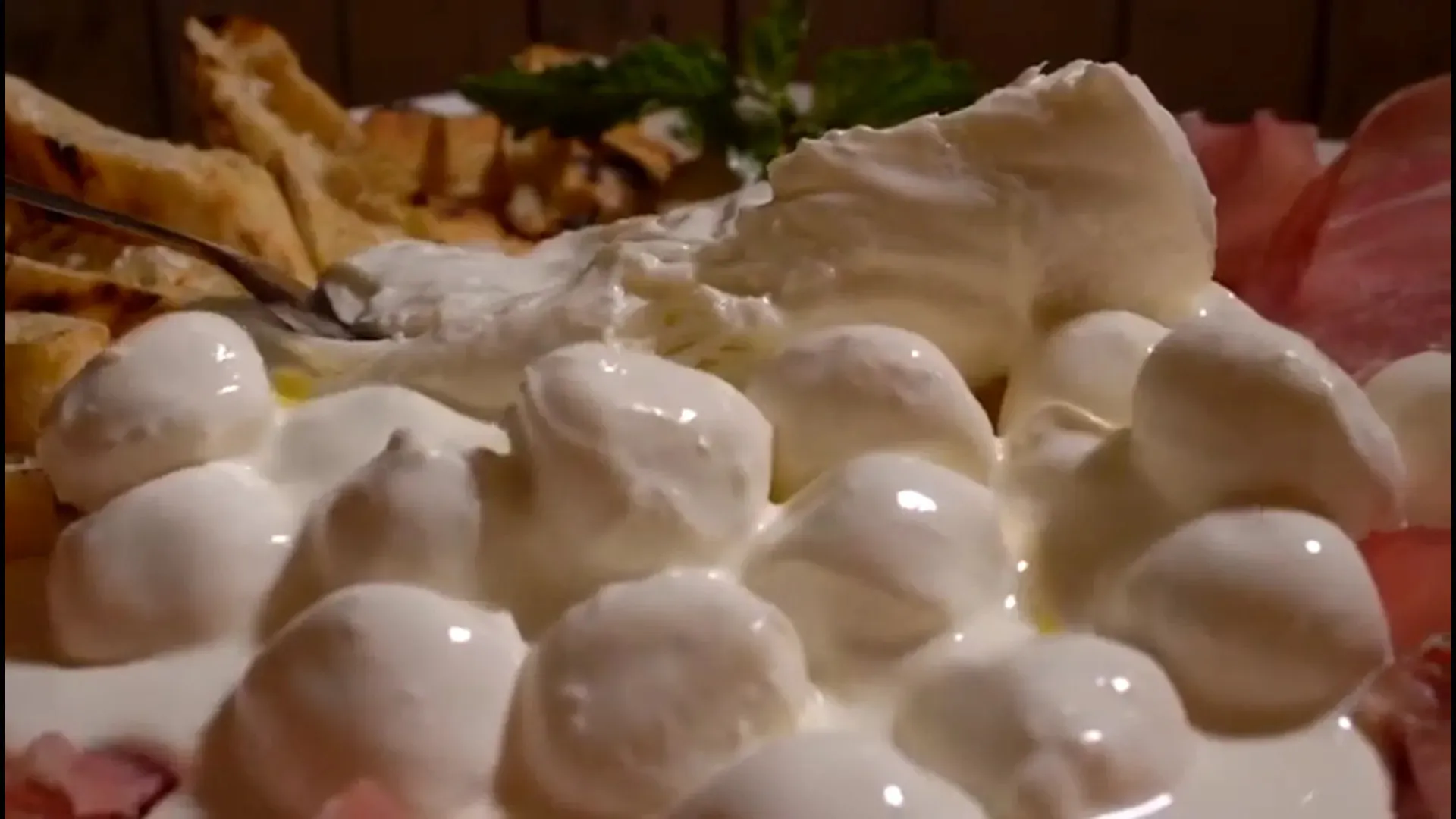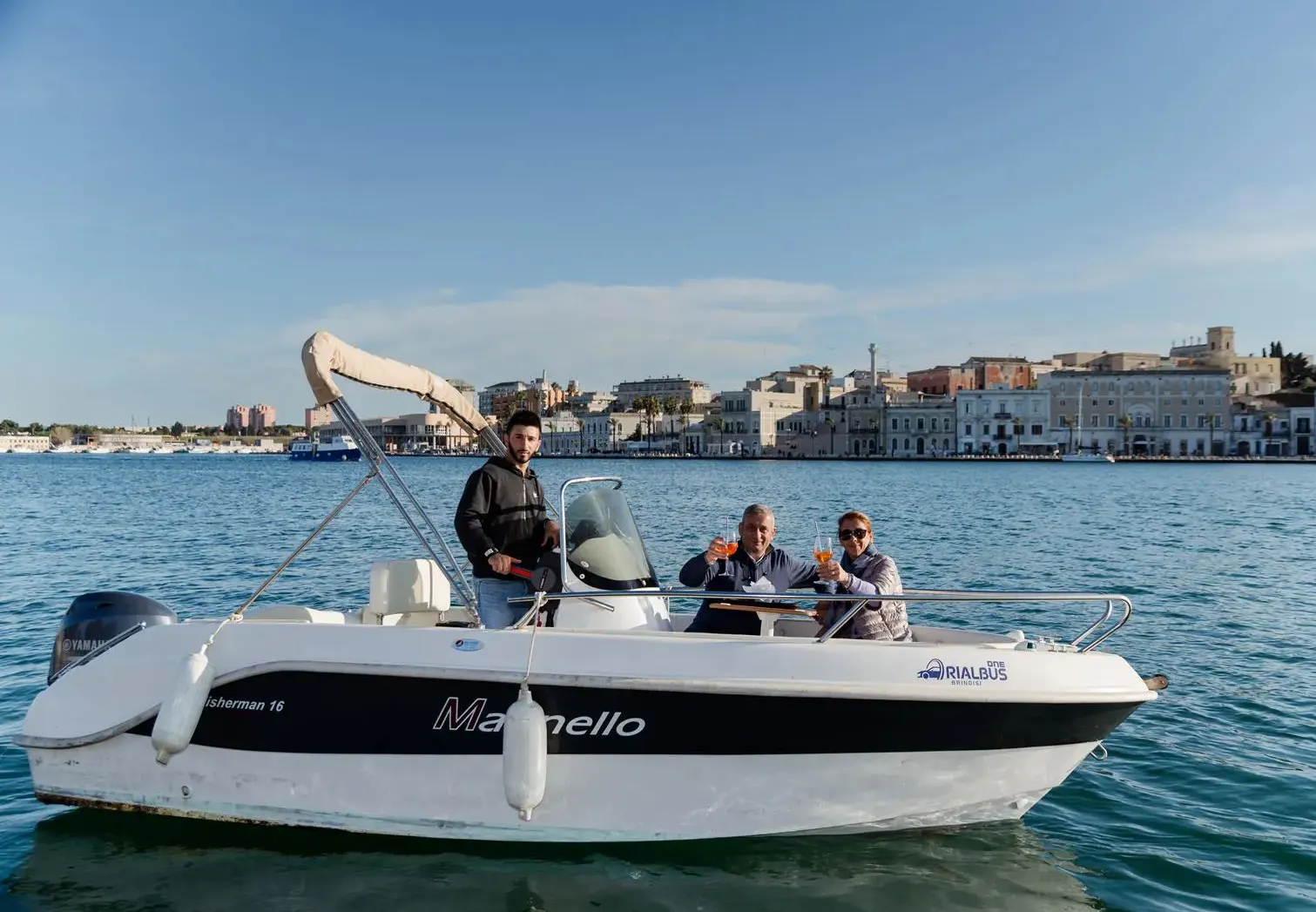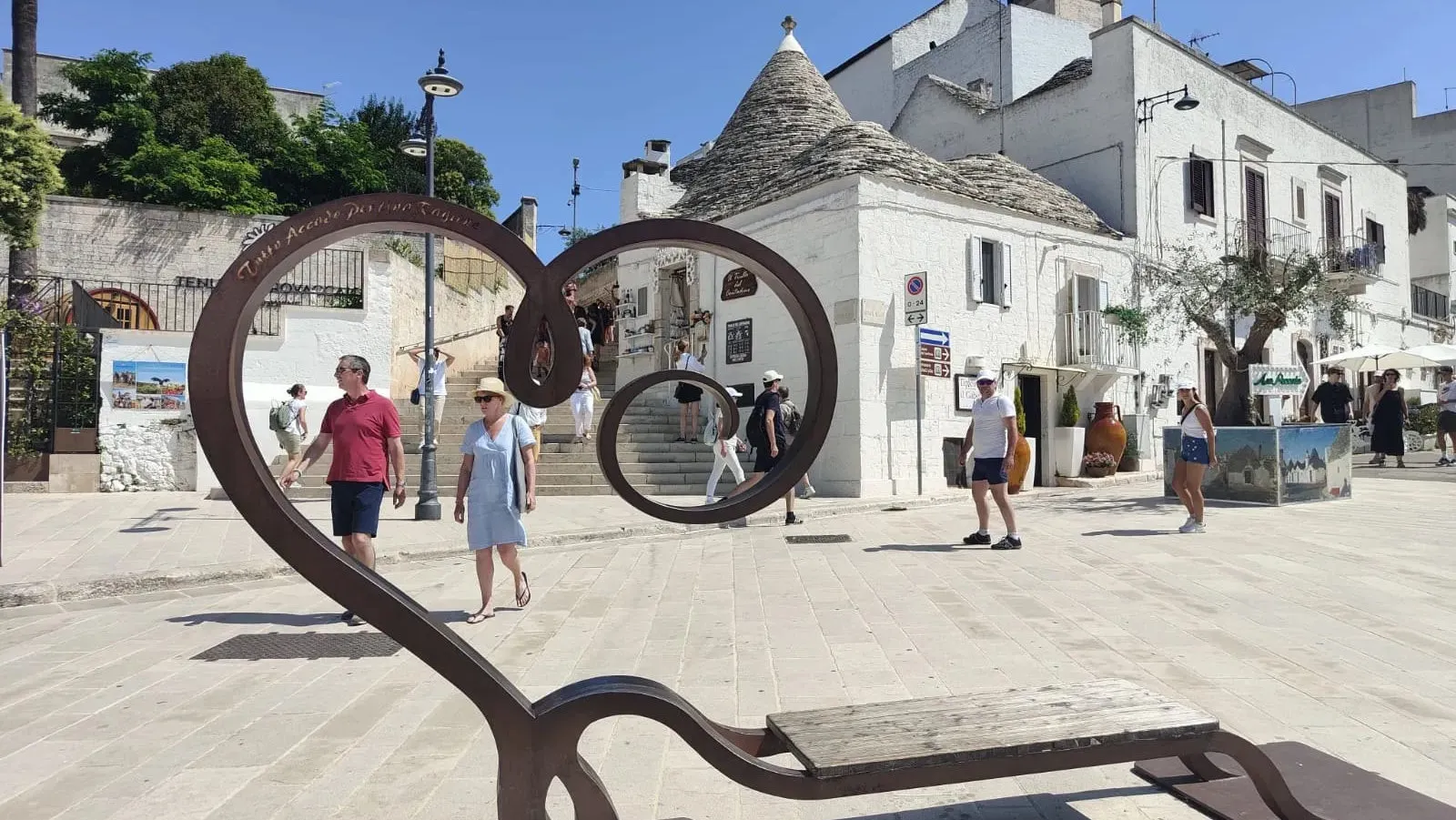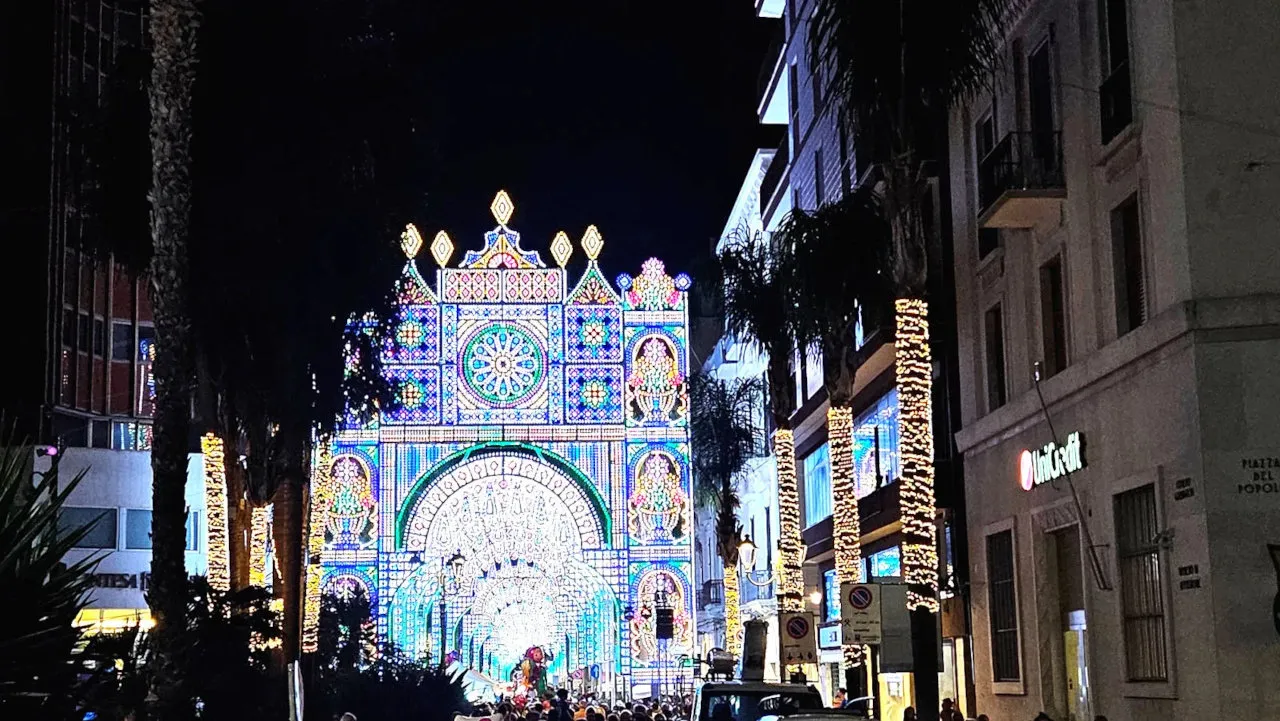Ostuni, what to do and see in the white city
Updated at: 20-09-2024
How this content can help you:
- You will discover the millennia-old history of Ostuni, the "White City," from its prehistoric origins.
- You will get to know the most picturesque places in the historic center, such as the Cathedral and Piazza della Libertà.
- You will learn about the most beautiful beaches of the Ostuni coast and how to reach them.
- You will discover events and traditional festivals, such as the Cavalcata di Sant'Oronzo.
- You will receive tips on how to make the most of your visit, including local cuisine and typical accommodations like masserie and trulli.
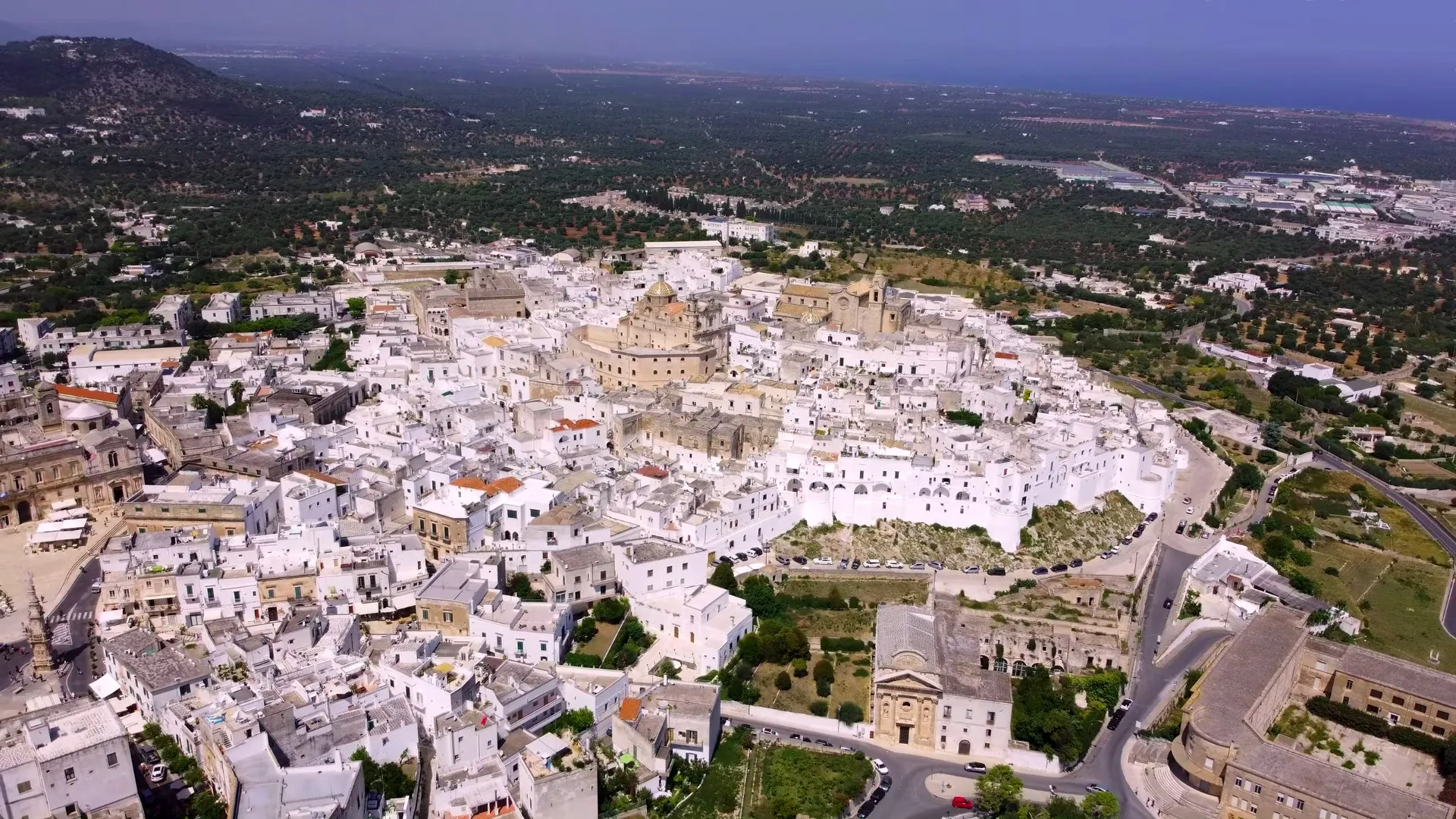
Why is Ostuni called the "White City"?
Ostuni is called "The White City" because of the characteristic white color of its houses, due to the use of lime for painting the facades of the buildings.
Welcome to Ostuni, the picturesque city located in the Salento region of Puglia, renowned for its characteristic historic center characterized by whitewashed buildings.
Ostuni, affectionately called the "White City", is spread over 3 hills north of Brindisi facing the Adriatic Sea. The historic center of Ostuni stands majestically on a 218 meter high promontory north of Brindisi, offering an enchanting view that ranges from the barren land of centuries-old olive groves to the crystal clear waters of the Adriatic Sea.
The peculiarity of Ostuni lies in its homes painted in lime white, which shine under the Apulian sun, creating a fascinating contrast with the blue sky and the green of the olive trees that surround the city.From the top of its hills, Ostuni dominates the Adriatic coast just 7 km away, offering breathtaking panoramic views that extend over the crystalline sea.
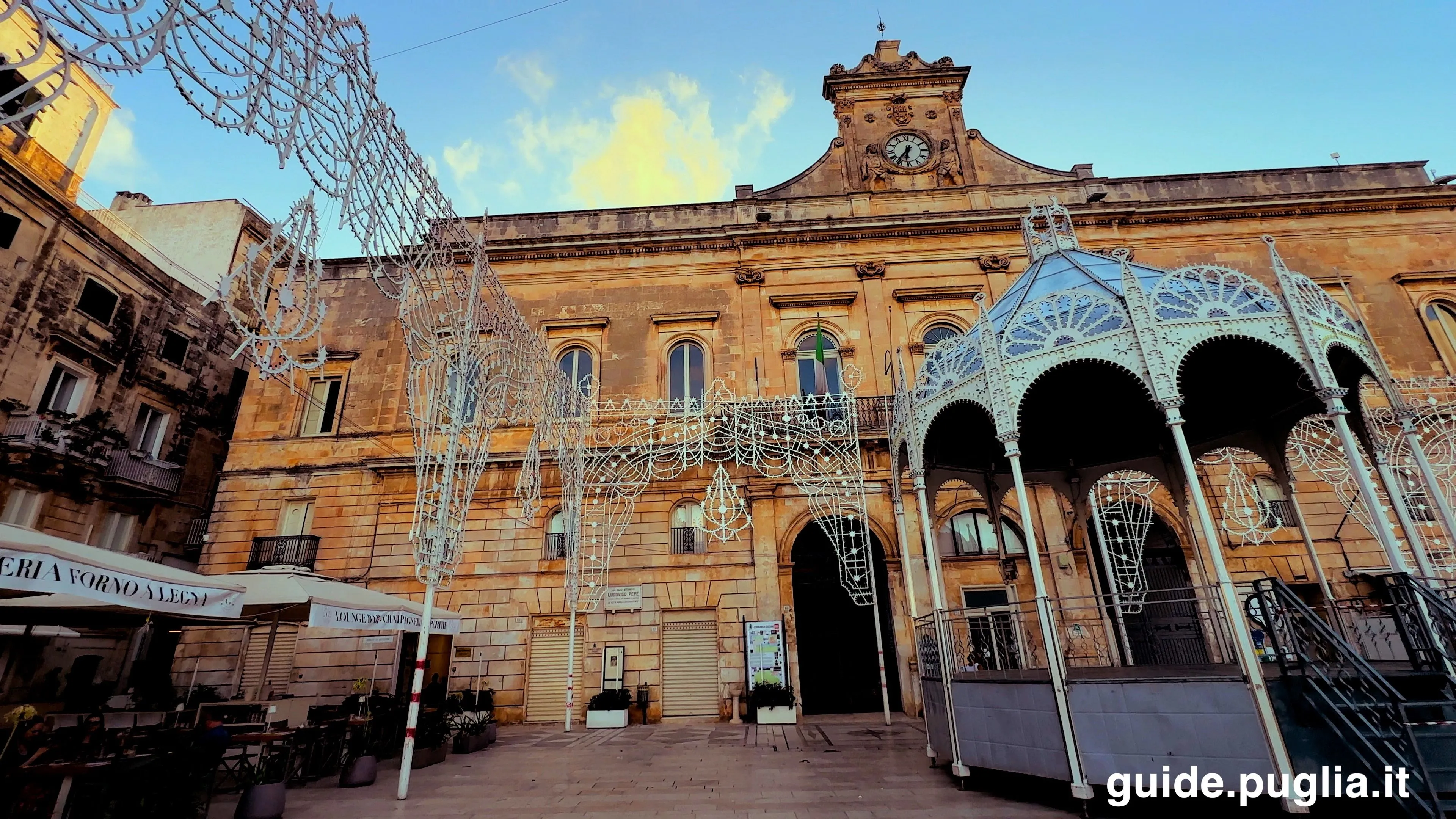
Crossing the walls of Ostuni means immersing yourself in a labyrinth of narrow streets, impervious stairways and hidden squares, where every corner reveals a history, an architecture or an artistic detail that refers to centuries of history. The historic center, closed to traffic, invites exploration on foot, allowing visitors to savor its charm.
It is not only the history that makes Ostuni a fascinating destination, but also the vibrant cultural and social life. The squares come alive with cafes, restaurants and artisan shops offering local products, reflecting the pride and passion of the Ostuni people for their land. During the summer, the city transforms, welcoming tourists from all over the world who are attracted by its beauty, its culinary traditions and the warm hospitality of its inhabitants.
The privileged location not only accentuates the scenic beauty of Ostuni Centro, but has also played a crucial role in its history, acting as a guard point against incursions in ancient times. Ostuni represents a perfect fusion of natural beauty, historical heritage and vibrant culture, making it emerge as one of the most intriguing destinations in Salento.
What to see in Ostuni
Among the most beautiful things to see in Ostuni are:
- Ostuni Historic Center
- Upper historic center
- Piazza della Libertà and Column of Sant'Oronzo
- Church of San Francesco d’Assisi
- Cathedral of Santa Maria
- Arco Scoppa
- Ostuni Botanical Garden
- Diocesan Museum of Ostuni
- Church of San Vito Martyr
- Porta San Demetrio and Porta Nova
- Sanctuary of the Madonna della Grata
- Tanzarella Palace
- Museum of Preclassical Civilizations of Southern Murgia
Ostuni is a very pleasant village to visit both for a day trip and for longer holiday periods.
If you want to stop and visit the palaces and points of interest of course one day is not enough, but the summer visitors who prefer to move every day to different places in Puglia will not be disappointed by the welcome and the open-air wonders that the city offers to travelers.
Ostuni Historic Center
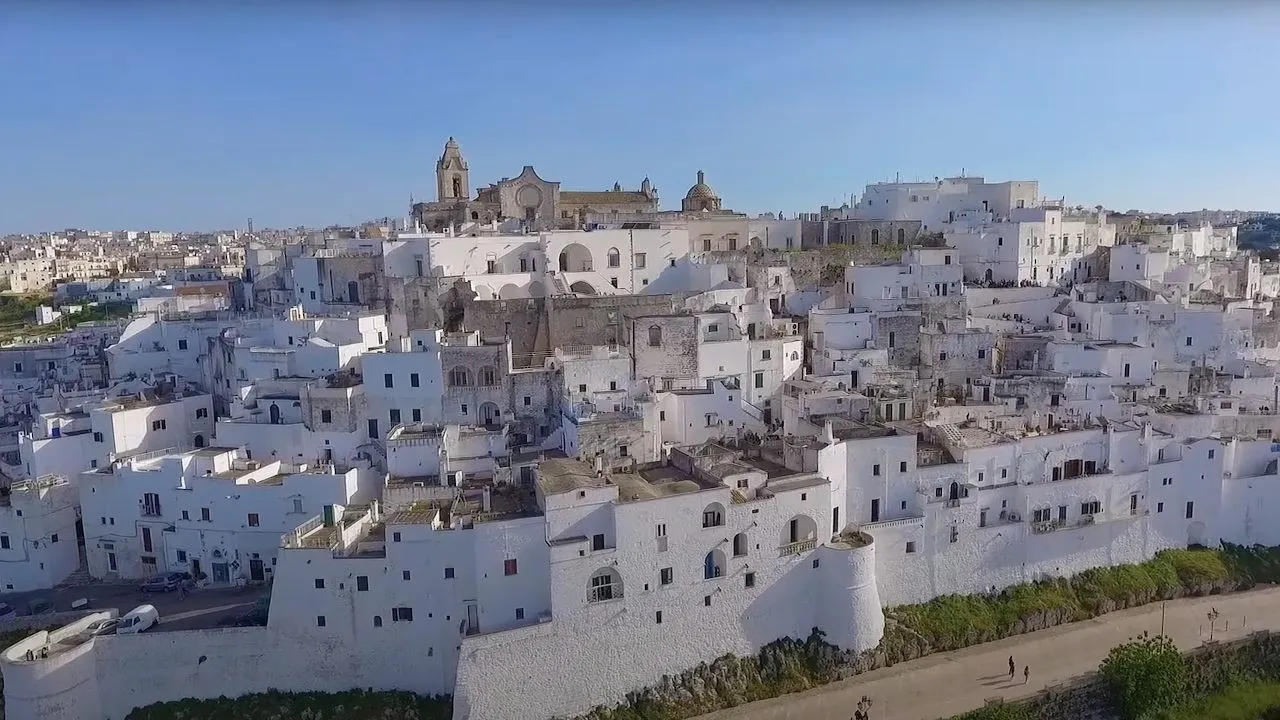
The ancient heart of Ostuni, known as "The Historic Center", is one of the main tourist attractions of the city. Known for its whitewashed homes, this labyrinth of narrow streets and stairways offers picturesque views at every turn.
Ostuni Centro is nicknamed "The Earth" by its citizens and stands on the sides of a fairly steep hill more than 200 meters high. A walk here is like taking a step back in time, where every wall and every stone seems to tell stories of bygone eras. Don't miss the Cathedral of Ostuni, a masterpiece of Gothic architecture that dominates the city with its imposing rose window and its elegant facade.
Surrounding the historic center, the ancient Aragonese walls, together with the two ancient entrance gates to the city Porta Nova and Porta San Demetrio, tell the story of the different dominations that marked Ostuni. These imposing defensive structures are an extraordinary example of military architecture and offer breathtaking views of the surrounding landscape, especially at sunset.
Ostuni Centro is the most human-sized part of the ancient village and is simply a pleasant place to visit and stroll, as it is absolutely forbidden to circulate on the streets with motor vehicles (except for exceptional services or supplies to the activities present).
In Ostuni Centro you find yourself immersed in a village of other times, rich in structures, works and views of such beauty as to arouse strong emotions.
Narrow and winding ancient streets, excellent cafes on the terraces and along the stone streets, restaurants with exceptional services, quaint craft shops with pottery, shoes, olive oil and much more will make your stay here.
It is possible to visit the enchanting historic center of Ostuni, if you are in a hurry, in a few hours walking up and down the hill, still managing to appreciate the hospitality and care of the citizens for their heritage and the wonders that the center offers. .
The best thing to do to fully appreciate what the city has to offer would be to stop for a few days in the surroundings and enjoy the different views of the city both day and night, in order to fully enjoy the beautiful things it has to offer. to offer.
The opportunities to stay in the historic center of Ostuni are not many, especially in the summer, but it is possible to find hospitality more easily in the farms, in the trulli and in the villas distributed in the countryside of the Itria Valley or near the sea.
€ 160
Upper historic center
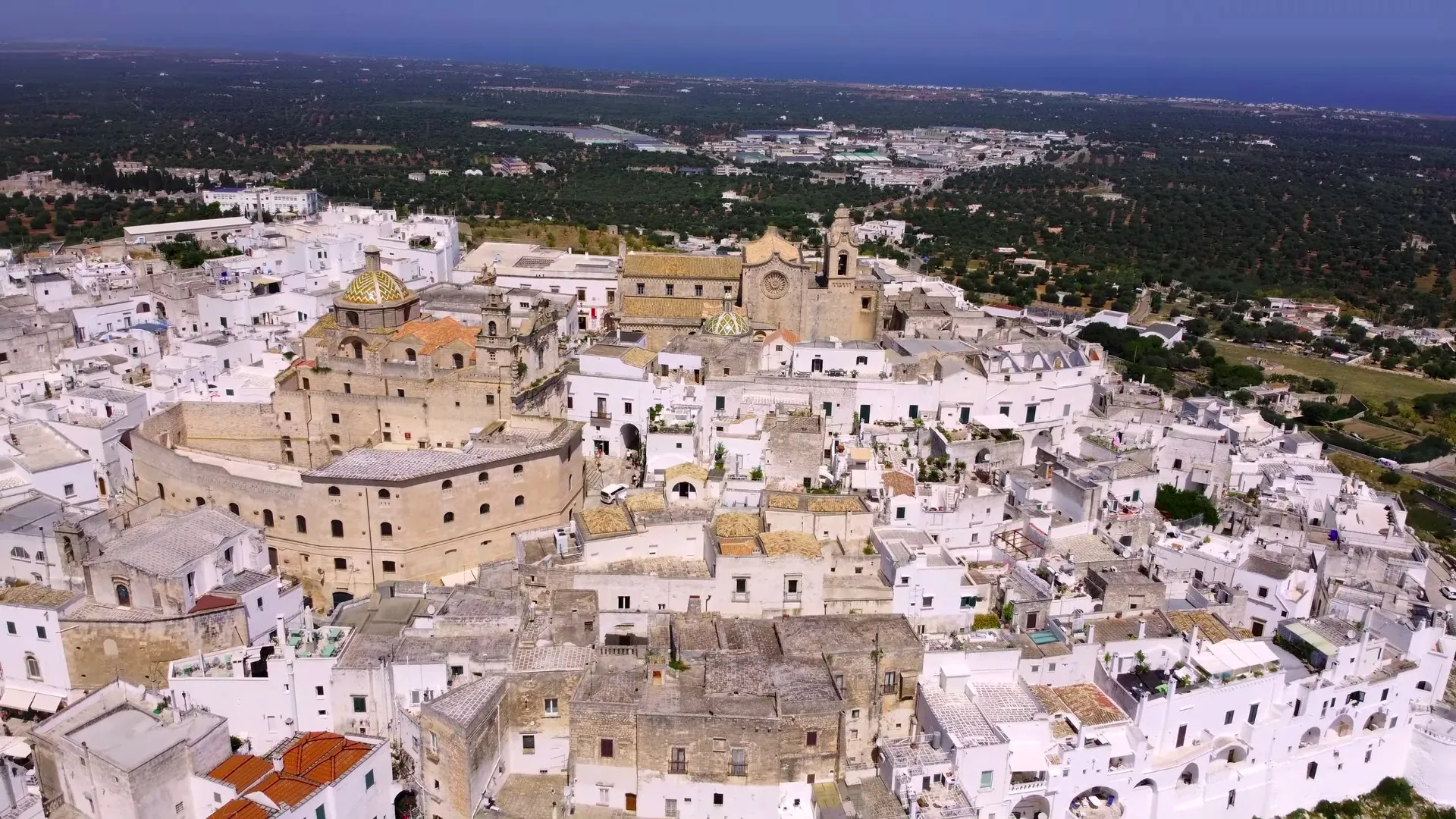
To get to the upper part of Ostuni Centro, above Piazza Libertà, you need to take an uphill walk or use a passage of one of the many gigs (the classic 3-wheeled Piaggio vehicles) until you get to the top where the ancient Cathedral is located. of Santa Maria.
While walking through the city center to reach the cathedral, located on top of the hill, you can enjoy the wonders of the morgo with its many particular views, its palaces, its churches and its breathtaking panoramic views.
Furthermore, it is very often allowed to visit the interior of the various churches, churches and historic buildings.
Among the things that you will absolutely notice, which you will be fascinated by, there are certainly the hundreds of pretty alleys.
We recommend a visit to one in particular of the alleys that stands out for its beauty and for the breathtaking view it offers to visitors, Vico Castello.
Piazza della Libertà and Column of Sant'Oronzo
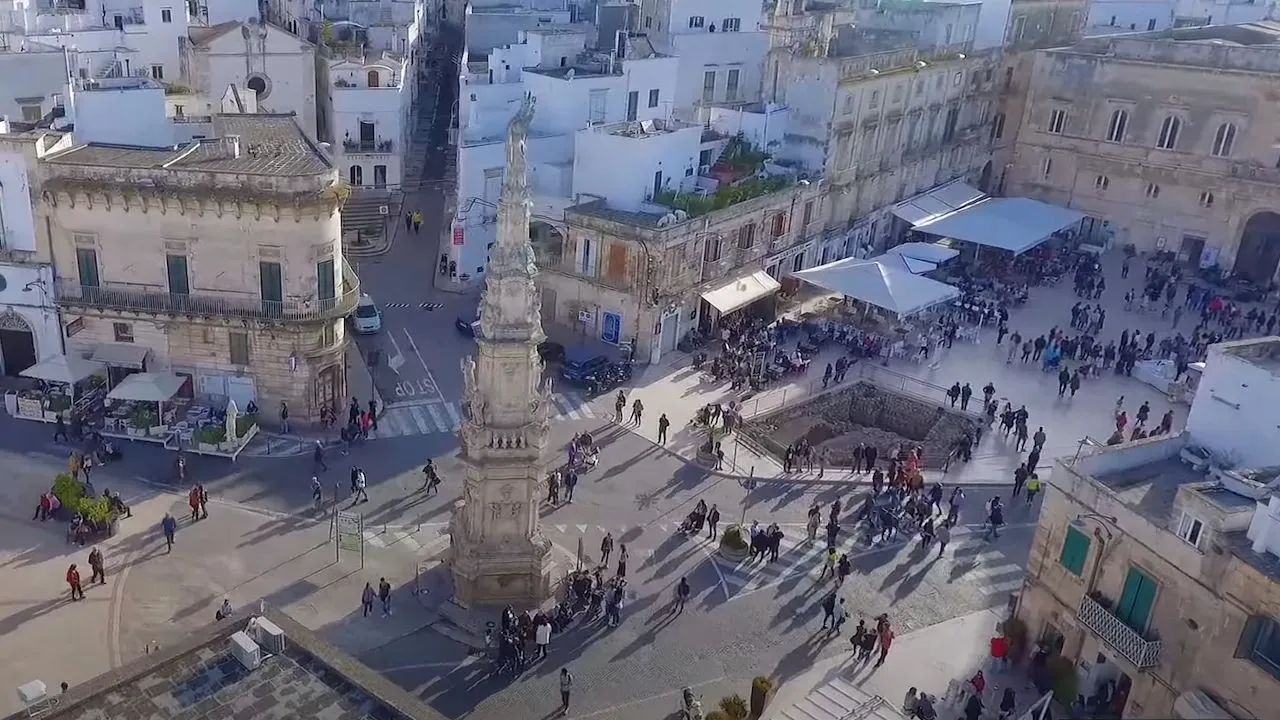
At the center of city life, Freedom Square is the ideal place to soak up the local atmosphere.The square is surrounded by cafes and restaurants where you can enjoy an aperitif or an outdoor dinner, letting yourself be enchanted by the continuous movement of urban life.
In the square are located the most important public buildings of the city and the Column of Sant'Oronzo, a 20-meter-tall Baroque column from 1771 dedicated to Saint Oronzo, the protector of the city.
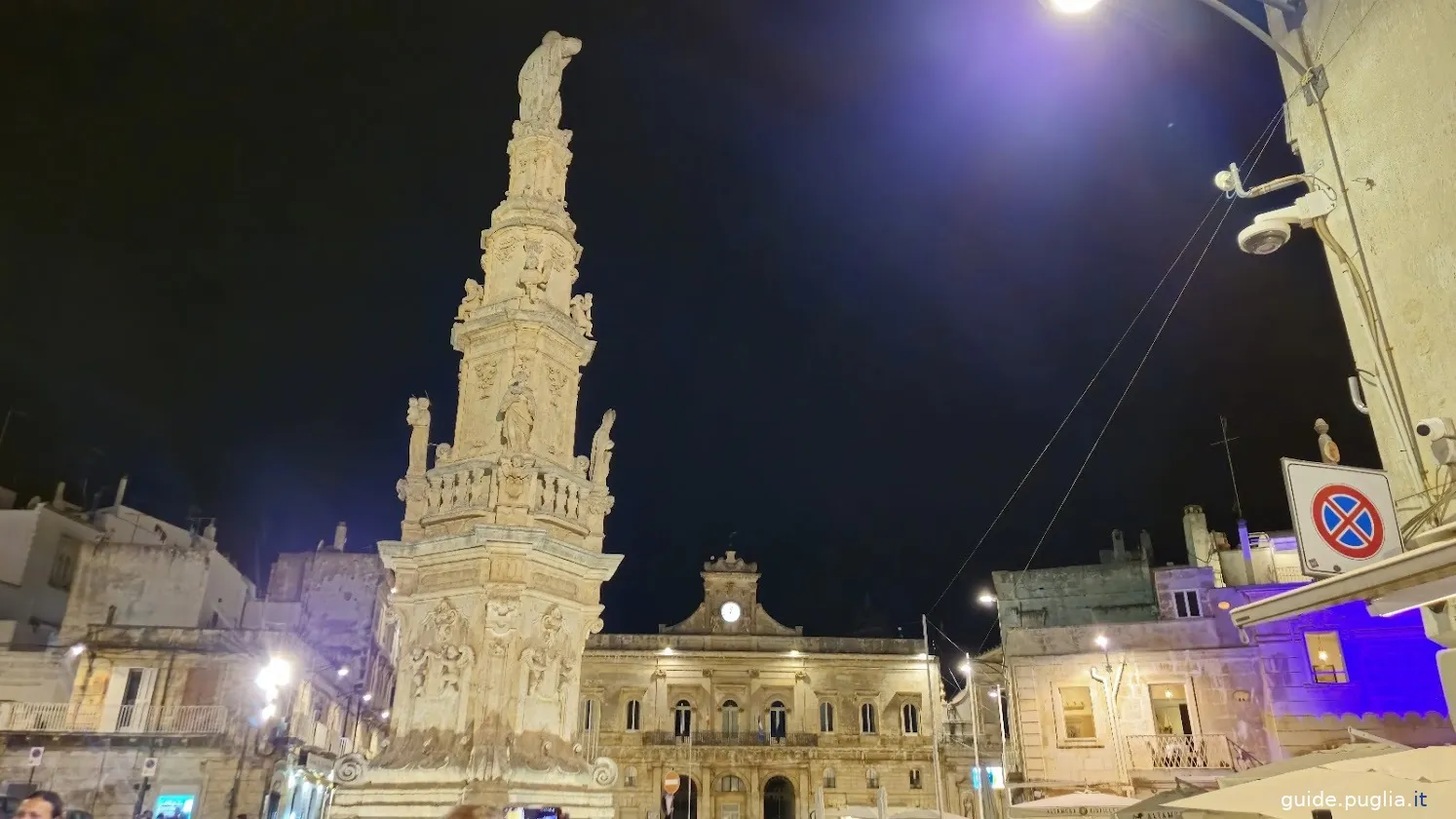
At the top of the column stands the bronze statue of the saint. Saint Oronzo is depicted in episcopal garments, with his right hand raised in blessing and his left hand holding the pastoral staff, symbolizing his role as a spiritual guide. The statue is a focal point, visible from various points in the city, and dominates the square below, watching over the people of Ostuni and visitors.
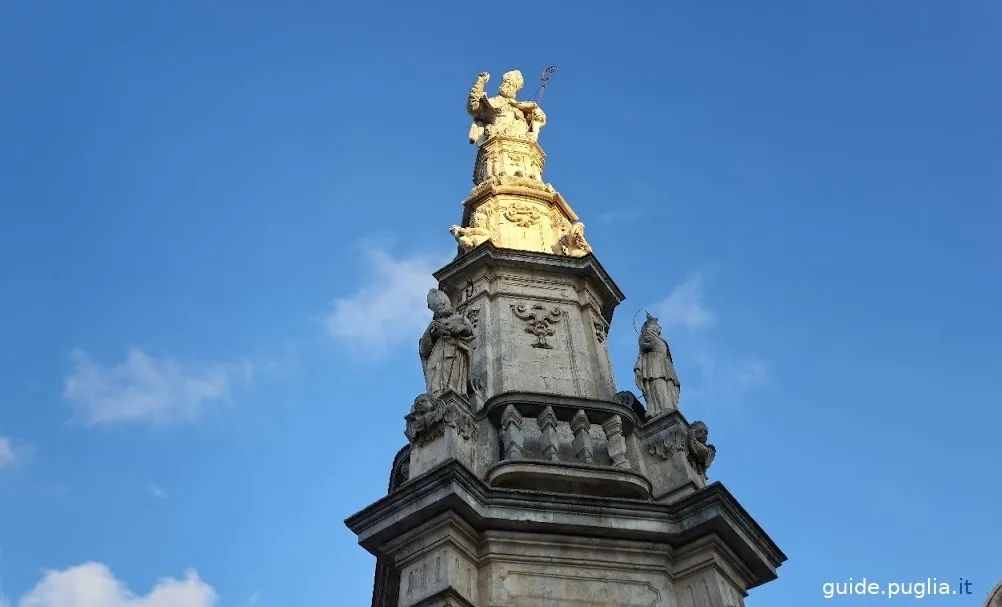
Piazza Libertà, like all of Ostuni Centro, is exceptionally lively in summer as it is lined with restaurants, bars, ice cream parlors, taverns and many other quality services that offer refreshment and space to relax and taste local delicacies.
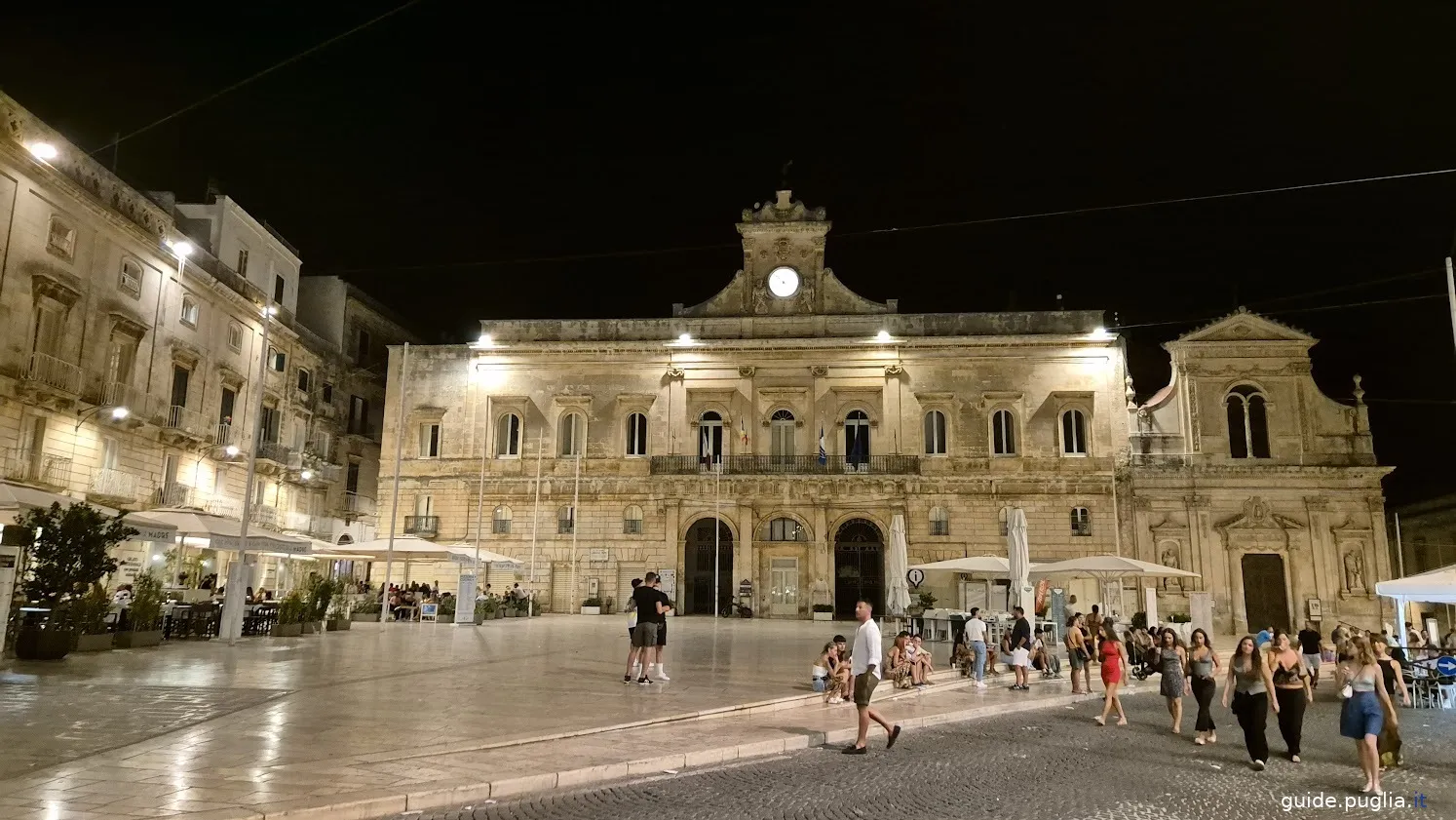
It is the beating heart of the city and it is a pleasure for visitors to come and discover it, stop for an aperitif and enjoy the view while having a chat or sipping an aperitif.
On one side is the Palazzo Comunale, formerly the seat of a convent, next to the church of San Francesco d'Assisi where you can enter for a visit.
The city center is made up of a dense and intricate network of streets, alleys, passages, arches and dead ends. Diving and walking through the narrow streets in the center is the best way to experience the historic center of Ostuni.
The main street is lined with bars and restaurants, alternating with boutiques and souvenir shops selling typical local products, such as olive oil and wines, and local works of art such as fine ceramics and wood carvings.
The only thing to pay attention to, especially in summer, is that many shops have a summer opening hours with an afternoon break that usually goes from lunchtime to late afternoon (from 1:30 pm to 4:30 pm approximately) .
If you plan to enter a particular venue during those times, the most sensible thing to do is to call before you go. In any case, you will certainly find some alternatives to your needs.
If you plan to shop or organize a lunch or an afternoon aperitif, it is important to keep in mind that you may find it closed.
Church of St. Francis of Assisi
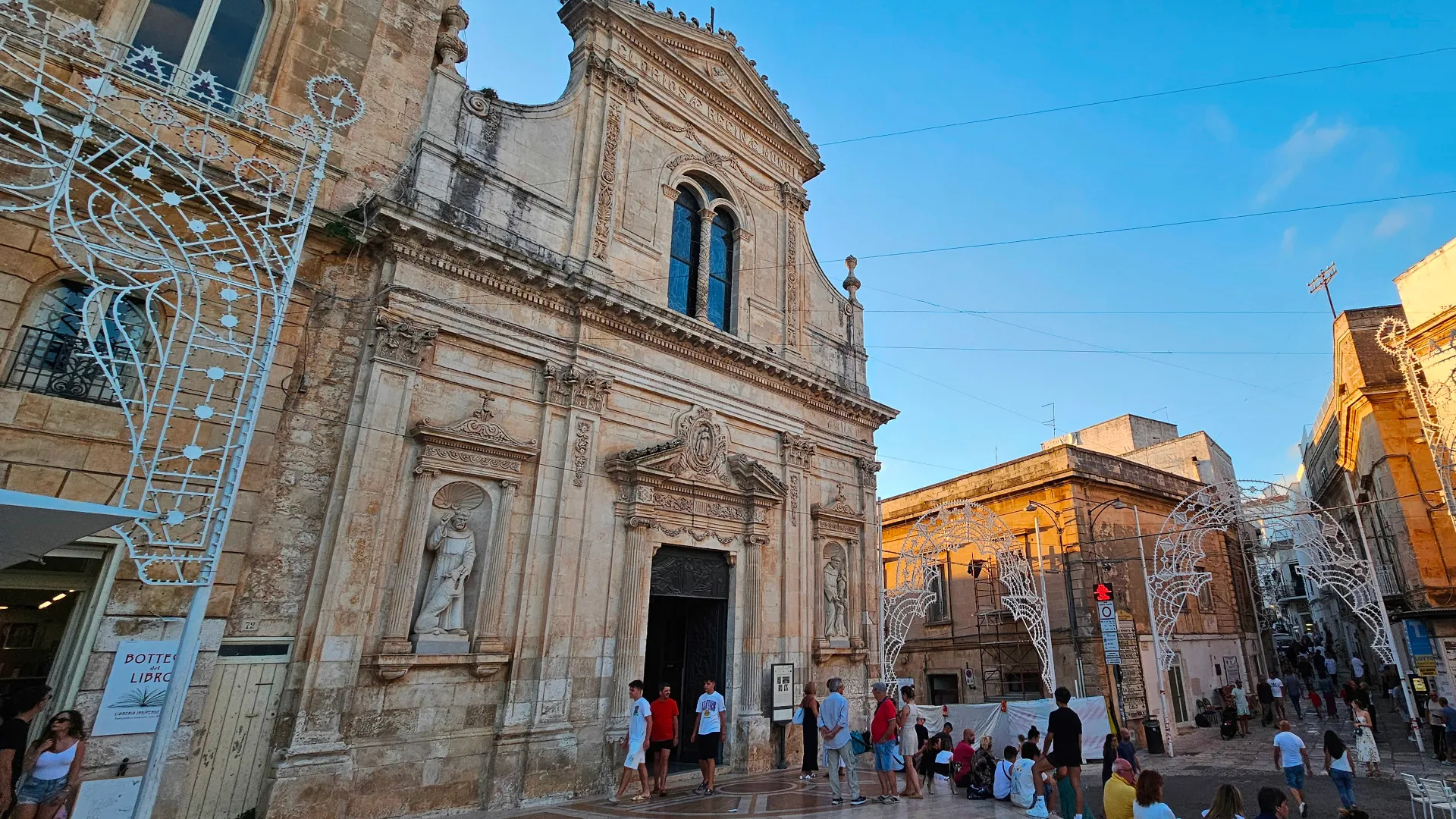
The Church of St. Francis of Assisi is located in Piazza della Libertà, in the heart of the historic center of Ostuni. The church is an example of Baroque architecture, characterized by elaborate decorations and rich details.
The exterior features a simple yet elegant facade, while the interior is richly decorated with stuccoes and frescoes dating back to the 17th and 18th centuries.
In addition to religious services, the church hosts cultural events and sacred music concerts. The church is situated in a central location, making it easily accessible and visible to tourists. Visiting the Church of St. Francis of Assisi offers the opportunity to explore an important historical and religious site in Ostuni.
Cathedral of Santa Maria
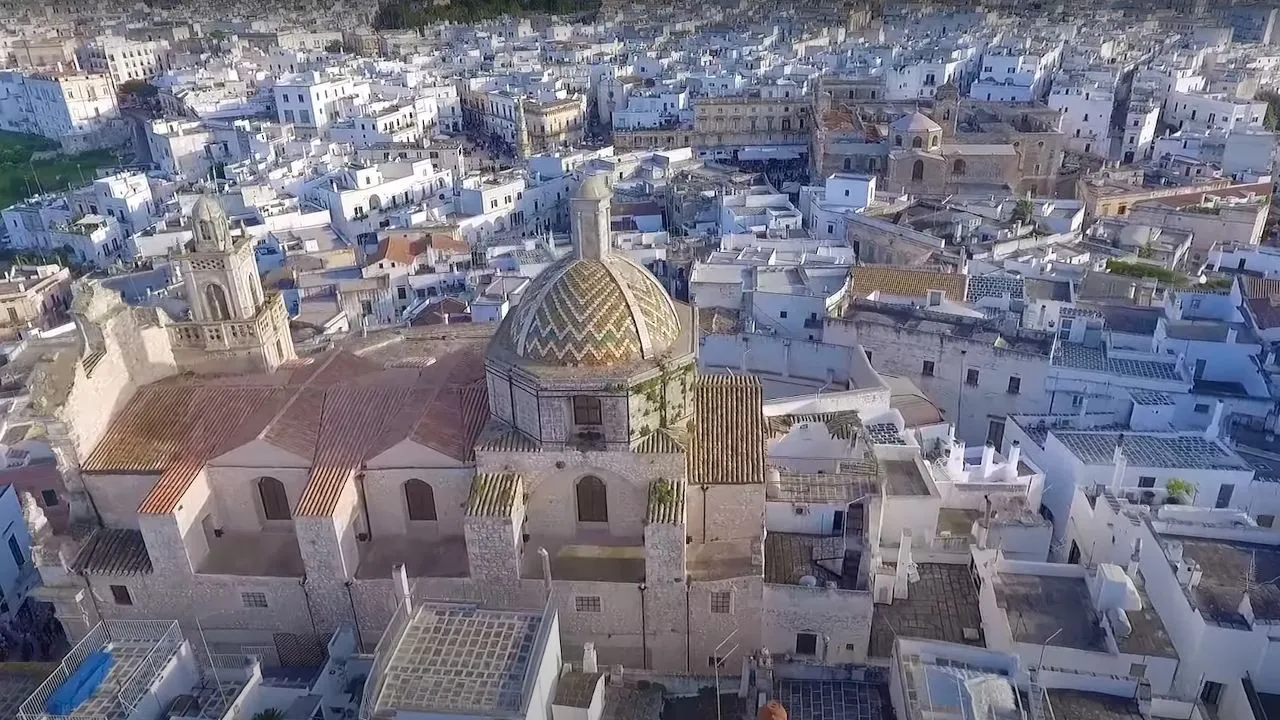
The cathedral is located in Piazza della Cattedrale, on a hill that dominates the city, offering a panoramic view of the surrounding countryside and the city itself. The cathedral was built between 1435 and 1495, replacing a pre-existing church. It is the main place of worship in Ostuni and is dedicated to the Assumption of Mary.
It serves as the city’s religious landmark and is the center of liturgical celebrations and local festivities. The cathedral is a true artistic gem built in the 15th century in a rare Gothic style for the region.
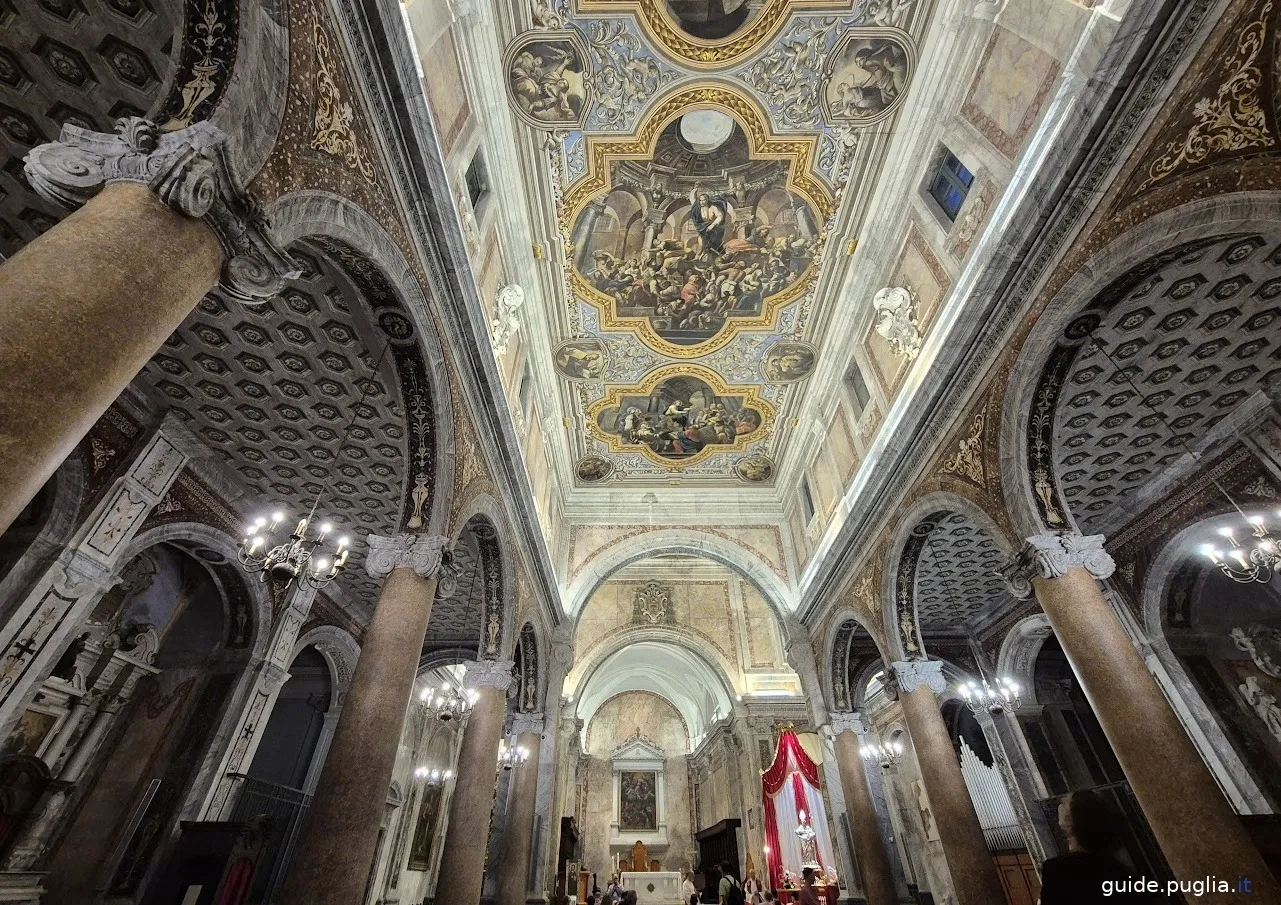
In fact, compared to other churches in Puglia, which are mostly of Romanesque or Baroque style, the Gothic style of this cathedral is quite unique.
Particularly noteworthy is the central ornamental rose window, located at the center of the main façade, which is one of the largest in the world of this style.
At the center of the rose window stands the figure of Christ, surrounded by finely adorned columns that represent the hours of the day. Among the most important artworks inside the cathedral are the finely carved stone pulpit and the wooden choir with elaborate details. The bell tower, about 54 meters tall, is one of the tallest in Puglia
Arco Scoppa
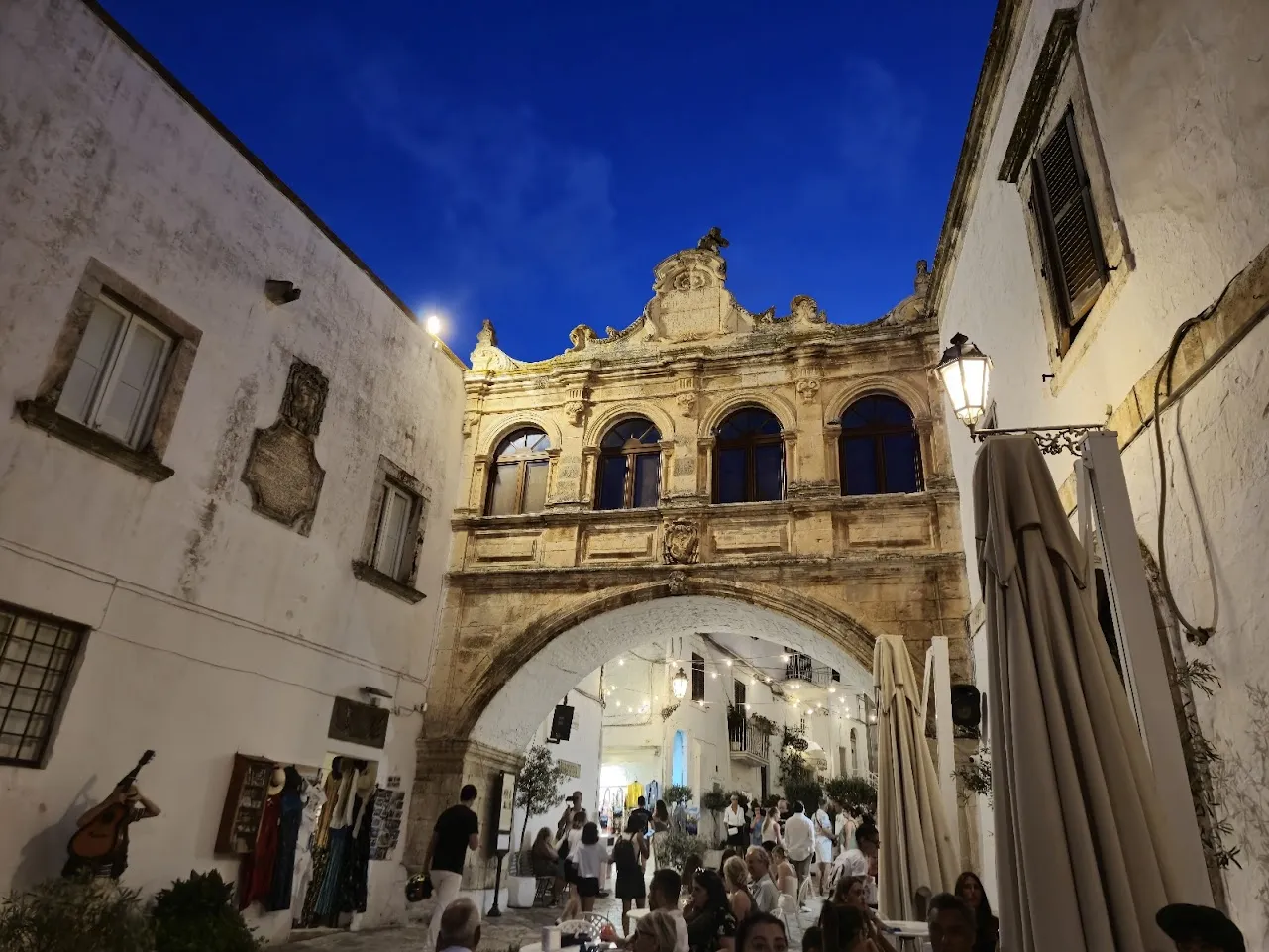
In front of the cathedral, at the top of the city of Ostuni, is this ancient stone arch of fine workmanship that frames the avenue on one side and the cathedral on the other.
The Loggia, the name with which the building is called by the citizens, was inspired by the bridge of sighs in Venice when it was rebuilt in 1750 due to the precariousness of the previous building, equally beautiful but no longer viable due to its first wooden construction.
The arch is still used today as a link between the bishop's palace and the seminary, the two buildings next to the Cathedral of Santa Maria at the highest point of the city.
Ostuni Botanical Garden
A small hidden jewel is the city's Botanical Garden, where you can discover the variety of Mediterranean and exotic plants, some of which are rare and protected.
This place offers a unique opportunity to relax and learn about the importance of biodiversity and environmental conservation.
By exploring Ostuni, every visitor can find their own corner of paradise, whether walking through the historic streets of the centre, relaxing on a deserted beach or venturing on nature excursions.
The Diocesan Museum of Ostuni
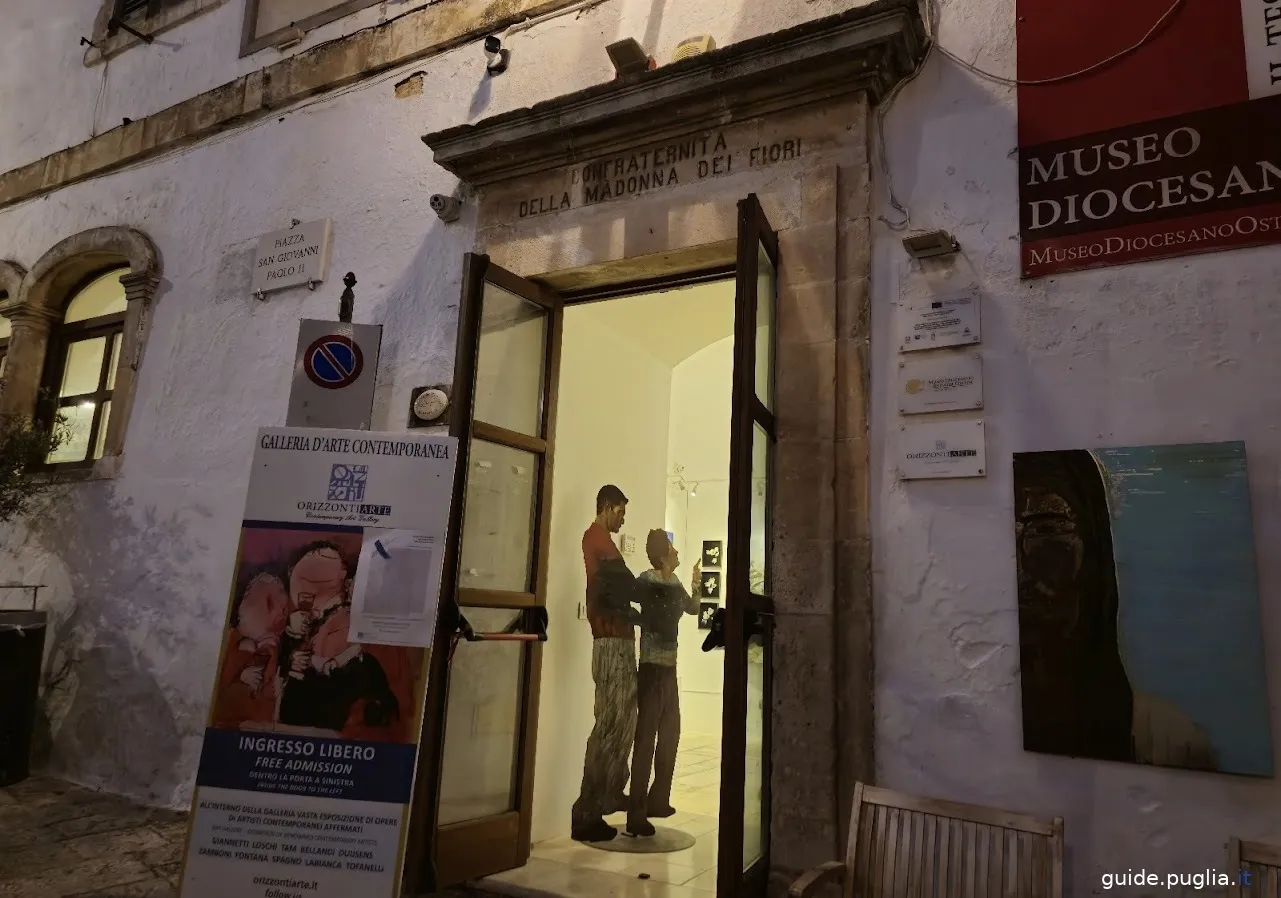
The Diocesan Museum of Ostuni is located inside the Bishop's Palace, a historic building situated in Piazza Beato Giovanni Paolo II. The museum is an important cultural space dedicated to the preservation and enhancement of the religious and artistic heritage of the diocese.
It houses a collection of sacred art that includes paintings, sculptures, liturgical vestments, manuscripts, and religious artifacts. Among the most important works are paintings by local artists, wooden and silver sculptures, and ancient liturgical books.
The museum also offers an overview of the ecclesiastical history of Ostuni and its diocese.
Opening Days: The museum is generally open from Tuesday to Sunday.
Hours: The opening hours are usually from 10:00 AM to 1:00 PM and from 4:00 PM to 7:00 PM.
Church of San Vito Martyr
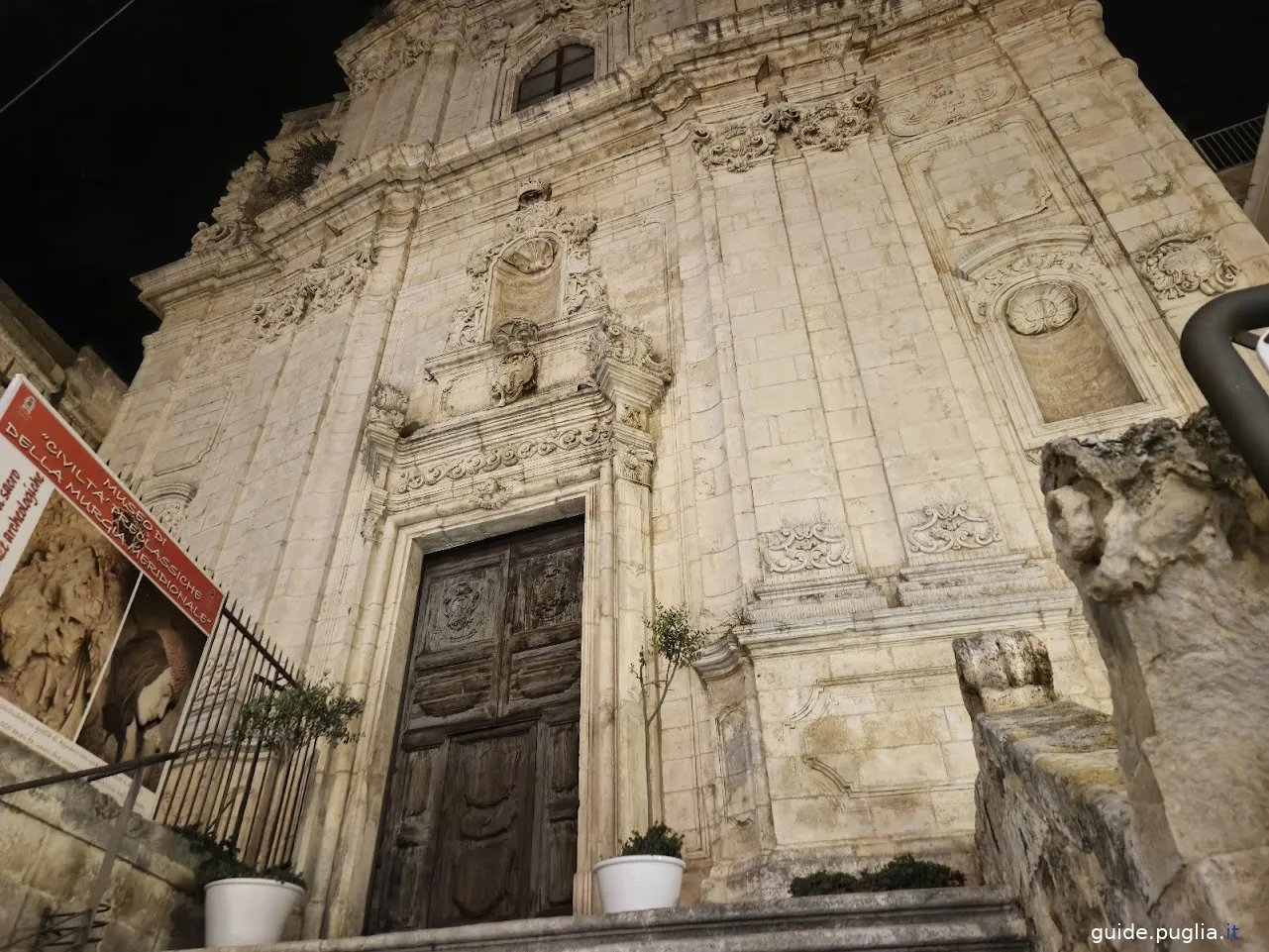
The Church of San Vito Martire is located in Piazza San Vito, in the historic center of Ostuni. The church is dedicated to San Vito Martire, a highly venerated Christian saint known as a protector against diseases and evil. San Vito is recognized for his martyrdom and devotion, and his cult is widespread in many Italian locations.
The church is characterized by a simple yet elegant architecture, with decorative elements reflecting the Baroque style typical of many churches in the region. The exterior is quite plain, but the interior features more elaborate decorations.
The Church of San Vito Martire was built between 1750 and 1753 by decision of Bishop Francesco Antonio Scoppa. The church has a rocaille style façade with a portal surmounted by the insignia of Bishop Scoppa and the Carmelite Order. The Carmelite monastery was built between 1710 and 1730 by order of Bishop Cono Luchino del Verme.
Hours: Typical opening hours are from 10:00 AM to 12:00 PM and from 4:00 PM to 7:00 PM.
Porta San Demetrio and Porta Nova
Porta San Demetrio and Porta Nova. Porta San Demetrio is located in the north-western area of the historic center of Ostuni. It opens onto one of the main streets leading to the heart of the city. The gate features a medieval style and is constructed from local stone.
It is characterized by a sturdy arch and architectural details that reflect the era in which it was built. The gate is dedicated to San Demetrio, a Christian saint who was likely venerated in the region.
Porta Nova is situated in the eastern part of the historic center of Ostuni, along the main street leading to the modern entrance of the city. The gate has a design that combines elements of medieval and Renaissance styles.
Both Porta San Demetrio and Porta Nova served as main access points to the city, allowing the passage of people and goods while ensuring control over the entrances to the fortified city.
Santuario della Madonna della Grata
The Santuario della Madonna della Grata is located in Ostuni, in Puglia, Italy. It is situated a few kilometers from the historic center of the city, immersed in a natural setting that enhances its spiritual and cultural appeal.
The Madonna della Grata is considered a protector and intercessor in times of difficulty and illness. The sanctuary is characterized by a Baroque style with local influences. The interior is richly decorated, featuring a central altar dedicated to the Madonna della Grata, embellished with golden stuccoes and precious marbles.
The altar is adorned with a statue of the Madonna, which is the focal point of the sanctuary.
Tanzarella Palace
Palazzo Tanzarella is located in the historic center of Ostuni. It is situated on Via Cattedrale, not far from the Cathedral of Santa Maria Assunta, in a central position that makes it easily accessible during a walk through the ancient village.
Palazzo Tanzarella is one of the most important historical buildings in Ostuni. It has been a symbol of the power and wealth of the local noble families, who played a crucial role in the city's history.
Palazzo Tanzarella is not always regularly open to the public, as it is a private property. However, on special occasions, such as cultural events, exhibitions, or during the "FAI Days", the palace can be visited.
Museum of Preclassical Civilizations in the Church of San Vito Martire
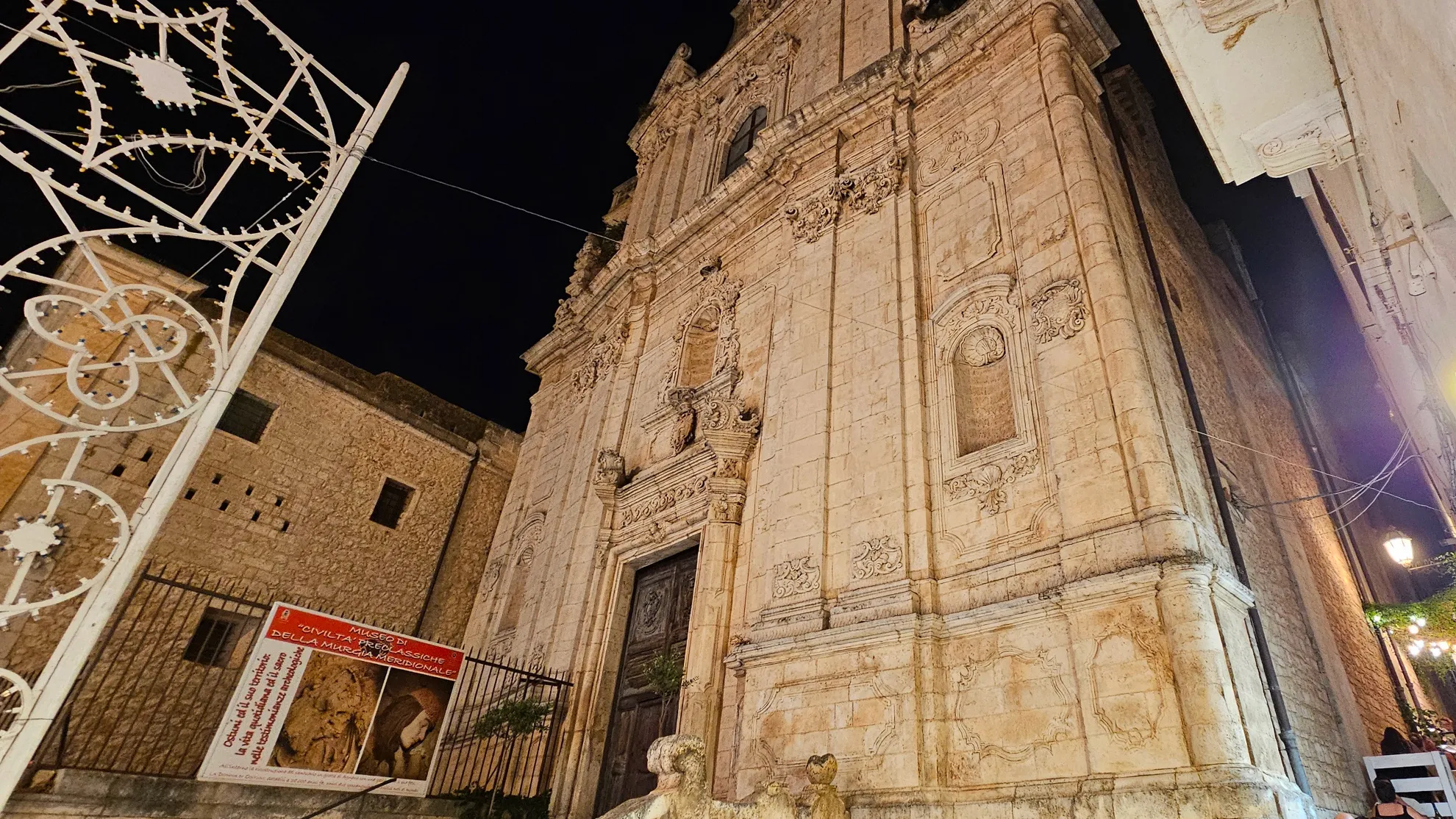
The Museum of Preclassical Civilizations of Southern Murgia is located in the historic center of Ostuni, inside the Church of San Vito Martire, built in the 18th century, which also annexes the former Convent of the Carmelite Nuns of Clausura. This historic building is located in Via Cattedrale, near the Cathedral of Ostuni.
The museum is dedicated to prehistory and the early civilizations that inhabited the region of the Southern Murgia, with a particular focus on the area around Ostuni. Among the most important collections in the museum are:
- The Woman of Ostuni: This is undoubtedly the most famous exhibit in the museum. It is the skeleton of a pregnant woman dating back to about 28,000 years ago, one of the oldest known burial testimonies, found in the caves of the Murgia.
- Archaeological Finds: The museum houses a wide range of artifacts, including stone tools, ceramics, and bronze and iron artifacts, which tell the story of the daily life, culture, and religious practices of the pre-classical populations of the region.
- Thematic Sections: The museum is organized into different sections that cover the geology, paleontology, and archaeology of the Southern Murgia, offering a comprehensive overview of the ancient history of the area.
Opening hours of the museum may vary depending on the season and special events. However, the typical opening hours are:
- Tuesday to Sunday: from 10:00 AM to 1:00 PM and from 4:00 PM to 7:00 PM.
- Closed on Mondays
Entrance Fees:
- Full Ticket: Generally, the entrance fee is around 5-7 euros for adults.
- Reduced Ticket: There are discounts for children, students, seniors, and groups, with prices ranging between 3-5 euros.
- Free Admission: Free admission days are sometimes offered, especially during cultural events or on particular commemorative days.
Ostuni Beaches
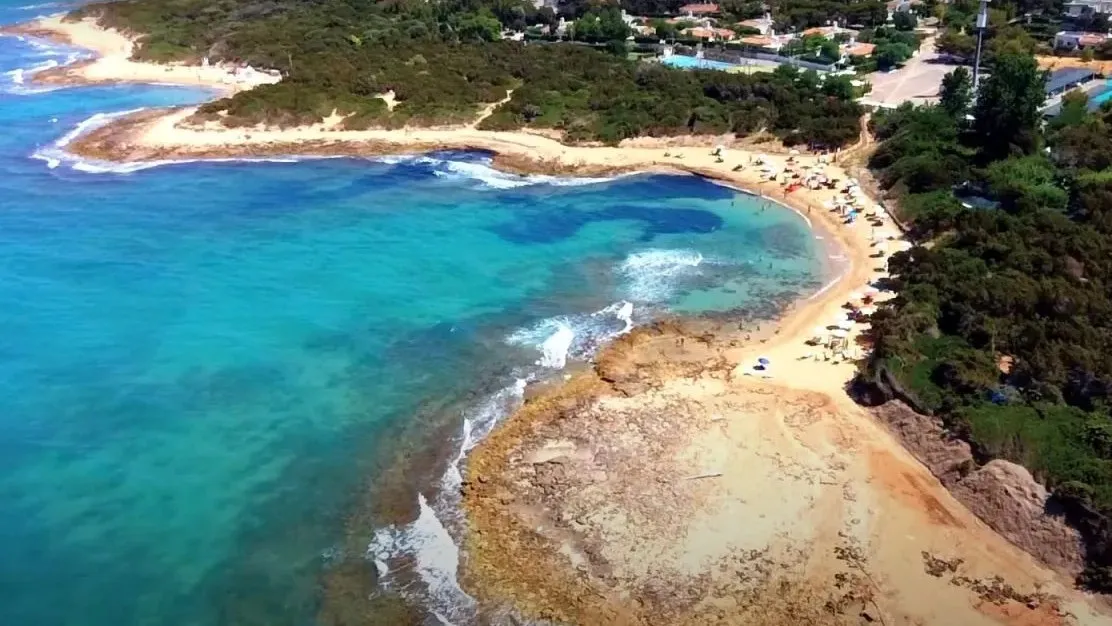
The sea coast of Ostuni is a rich and thick Mediterranean scrub that extends for 17 km in front of Ostuni. The heart of Ostuni sea are the many kilometers of Nature Reserves and areas where circulation by car and boat is prohibited.
The Ostuni marina is one of the points in Puglia where it was decided to preserve the wild nature of the coast but where free access is allowed to swimmers as long as they respect the imposed limits.
Beyond a few well-equipped beaches, with large guarded car parks and high-level services, there are many beaches in Ostuni that can only be reached on foot as they are scattered within the Nature Reserve on the sea coast of Ostuni.
If you want to go to the Nature Reserves on the coast of Ostuni, in most cases you need to travel by car. In this case the car must be parked far from the beach, in public car parks and walk, or use the paid public shuttles present in the car parks, to get closer to the sea.
History of Ostuni

Ostuni, with its imposing presence on three hills of the Apulian Murgia, has experienced a rich and fascinating history that begins in the Middle Paleolithic, a period during which traces of human presence are already recorded. This remote past is manifested through the discovery of the exceptional skeleton of the "Ostuni woman", a young woman in an advanced state of pregnancy, found in the cave of Santa Maria di Agnano. This discovery, dated to approximately 25,000 years ago, highlights the site's long history of human occupation.
With the arrival of the Neolithic, the area around Ostuni became an important center for agricultural communities, as demonstrated by the finds found in places such as Lamaforca and San Biagio. However, it was in the 7th century BC. that Ostuni took on a more defined form with its foundation by the Messapians. This people, of Illyrian or Anatolian origin, was known for their skill in building roads and fortifications. The choice of the site was not random, but responded to specific defensive needs: the hills on which Ostuni stands offered a privileged view of the access roads, making the city easily defensible.
During the Iron Age, and then under Roman rule starting from the 3rd century BC, Ostuni prospered as demonstrated by the numerous rustic Roman villas that dot the area. In this period, the city was an important commercial and agricultural hub, thanks also to its strategic position between the Via Traiana and the Adriatic coast.
The arrival of the Goths and subsequently the Lombards did not stop the development of Ostuni, which in the Middle Ages became a flourishing center under Byzantine control. In the 9th century, it became a bishopric, further strengthening its regional importance. However, it was with the arrival of the Normans in the 11th century that Ostuni experienced a period of great expansion. The new rulers strengthened the city's defensive structures and promoted agriculture, in particular the cultivation of olive trees.
During the Swabian period, under Frederick II, Ostuni enjoyed particular privileges, including exemption from taxes and an increase in military protection, which favored further economic growth. The king himself took the city under his direct protection, consolidating its strategic importance in the control of the territory.
The Angevin and subsequently Aragonese dominions brought new structural changes, with the construction of additional walls and fortifications to protect the city from growing external threats. The choice of the site was not random, but responded to specific defensive needs: the hills on which Ostuni stands offered a privileged view of the access roads, making the city easily defensible. This period also saw the re-establishment of the port of Villanova, which further strengthened Ostuni's position as a commercial centre.
In the Renaissance, Ostuni reached the peak of its prosperity, so much so that it was recognized as one of the most important cities in Puglia. This period is witnessed by the construction of numerous noble palaces in the historic center, which still represent an important tourist attraction today.
However, with the advent of Spanish domination in the 16th century, Ostuni entered a period of crisis, aggravated by epidemics and famines. Despite this, the city managed to maintain a certain importance thanks to its impenetrable defenses and the economic vitality brought by agricultural production and craftsmanship.
The 18th and 19th centuries were periods of renewal for Ostuni, with the creation of important public works, such as the construction of the new cathedral. Furthermore, the promotion of education and the arts helped to further strengthen the city's cultural role in the region.
In the 20th century, Ostuni faced the challenges of modernity by jealously preserving its historical and cultural heritage, and today it is recognized as one of the most evocative and history-rich tourist destinations in all of Puglia. Its evolution from a small Neolithic center to a city of art and culture is a living testimony to the rich history of the Mediterranean. Over time, Ostuni has been able to adapt and thrive, becoming a symbol of resilience and beauty in the heart of Puglia.
Events and Festivals in Ostuni
Ostuni is a city that pulsates with life and tradition, particularly evident in its many events and festivals that take place throughout the year. The city comes alive particularly during traditional festivities, where the streets are filled with life, music and colours, offering visitors an authentic insight into local culture.
Ostuni's connection with the arts is deeply rooted in the history of the city. Numerous artists, writers and musicians have been inspired by the beauty and unique atmosphere of Ostuni. The city is home to various art galleries and exhibition spaces that promote both local and international talent.
Events such as exhibitions, workshops and meetings with artists enrich the city's cultural calendar, making Ostuni a point of reference for lovers of contemporary art.
These events are an open window on local culture and traditions, offering visitors an unforgettable experience and the chance to completely immerse themselves in the spirit of the city.
Cavalcade of Sant'Oronzo
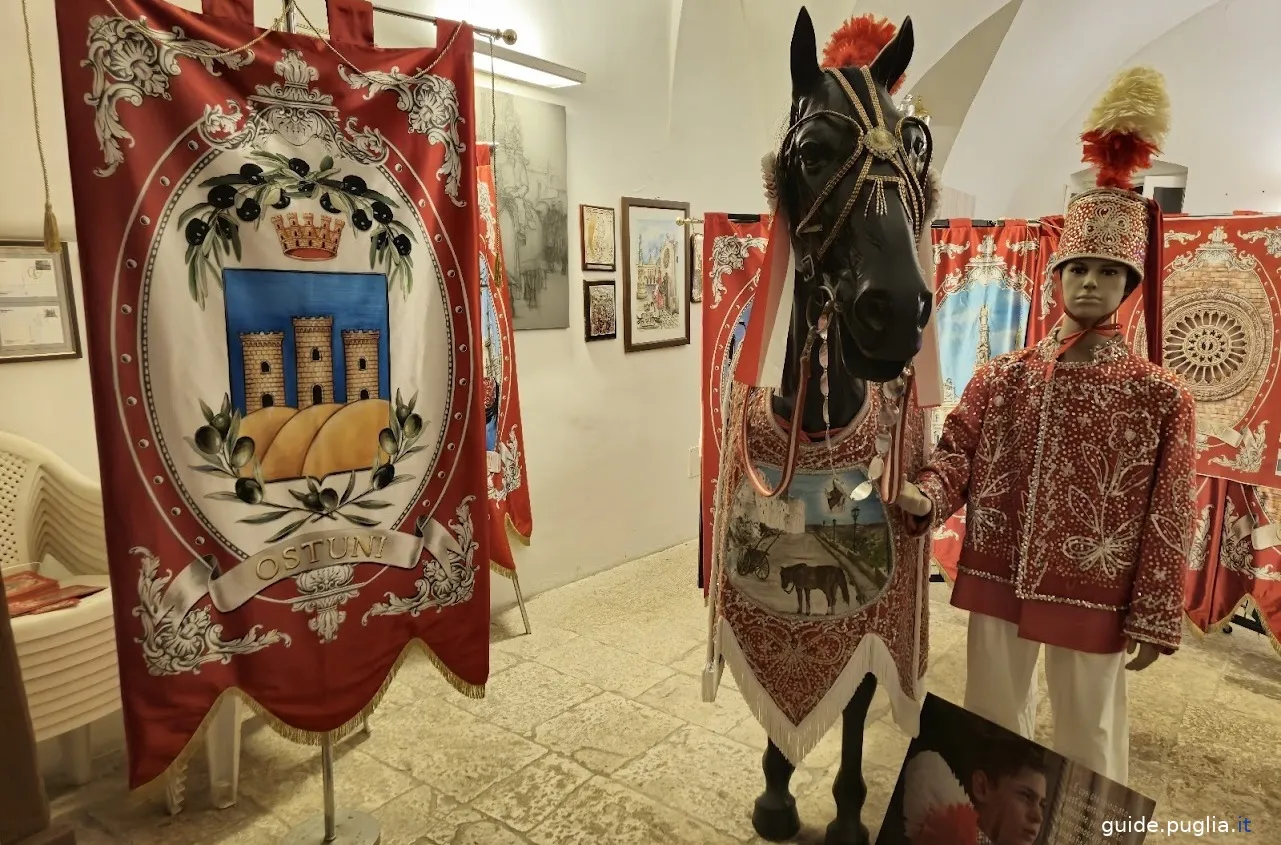
One of the most emblematic events of Ostuni is the Cavalcata di Sant'Oronzo (Cavalcade of Sant'Oronzo), a festival which takes place every year from August 25 to 27. This festival celebrates the city's patron saint, Sant'Oronzo, who according to legend saved Ostuni from the plague in the 17th century. The festival opens with a spectacular procession where the knights, dressed in traditional costumes, parade through the city streets until they reach the main square. The highlight of the event is the blessing of the horses and riders, a moment of great emotion and devotion that attracts thousands of spectators.
The festival opens with an impressive procession, where the statue of the saint is transported through the streets of the historic centre, followed by a procession of faithful and accompanied by musical bands. The evenings are enlivened by concerts, fireworks and stalls selling typical products and local crafts. This festival, in addition to being a moment of great religious devotion, represents an opportunity for the community to meet and a tourist attraction that enlivens the Ostuni summer.
The Ostuni Film Festival
For cinema enthusiasts, the Ostuni Film Festival represents an obligatory stop. Organized in July, this festival is dedicated to the promotion of independent Italian and international films.
The screenings take place in various evocative locations in the city, including ancient courtyards and squares set in the urban fabric of the White City. It is an opportunity to discover new talents and cinematic visions, as well as enjoy the beautiful summer evenings in Ostuni.
Feast of the Madonna della Nova
The Feast of the Madonna della Nova is held every year at the beginning of September and sees great participation from both locals and tourists.
The festivity begins with a procession that brings the statue of the Madonna from the countryside to the city, followed by solemn masses and a large fireworks display that lights up the night sky of Ostuni. It is a festival that combines religious devotion with community celebrations, reflecting the deep bond of the Ostuni people with their land and their faith.
The Old Times Festival
An immersion in the taste and food and wine traditions of Ostuni can be experienced by participating in the Sagra dei Vecchi Tempi.
This event generally takes place in August and offers visitors the opportunity to taste traditional dishes of Apulian cuisine, prepared according to ancient recipes.

The festival is not only an opportunity to enjoy exquisite food but also to enjoy live music, dances and traditional games, which make the atmosphere festive and welcoming.
The White Night
The White Night of Ostuni is another event that enlivens the city's summer. During this special night, usually in July, shops, art galleries and clubs stay open until late at night. The streets are filled with street artists, musicians and performers who transform the city into an open-air stage. It is a festival of culture and art that attracts visitors from across the region and offers a unique experience of shopping, culture and entertainment.
Participating in these events in Ostuni offers not only the opportunity to have fun but also to better understand the history and local traditions that make this city such a special place. Every festival and celebration in Ostuni is an important piece of the cultural mosaic that characterizes this wonderful Apulian city.
Outdoor summer shows
The cultural life of Ostuni extends not only to the cinema, but also to the theatre, with events taking place mainly in the summer months. The "Open-air Cinema" and theatrical performances in the historic cloisters or squares allow you to experience summer evenings under the starry sky, offering shows ranging from classical drama to modern independent productions.
€ 160
Local cuisine in Ostuni
The gastronomic experience in Ostuni is as much a journey through the unique flavors of Puglia as it is a discovery of the culinary traditions that have shaped this region over the centuries. Ostuni cuisine stands out for the use of fresh, seasonal ingredients, often grown in the surrounding fertile lands or fished in the crystal clear waters of the Adriatic Sea.
Typical dishes of Ostuni
One of the most iconic dishes of Ostuni, and of Puglia in general, is orecchiette with turnip tops. These small "orecchiette", homemade pasta that resembles small ears, combined with bitter turnip tops, represents one of the most loved combinations in local cuisine.
Another traditional dish is tiella, a tasty dish based on rice, potatoes and mussels, typically cooked in a round pan. This dish contains the flavors of the sea and the land, offering a perfect balance between the different elements.
For legume lovers, a dish of fava beans and chicory cannot be missing, a simple but nutritious preparation featuring broad beans reduced to cream and accompanied by sautéed wild chicory.
Local ingredients from Ostuni
Ostuni cuisine makes extensive use of extra virgin olive oil, one of the most precious and recognized elements of the Mediterranean diet. The olive groves surrounding the city are ancient and produce an oil with a rich and strong flavour.
Altamura bread, famous throughout Italy, is another fundamental ingredient, used both as an accompaniment to meals and as a base for bruschetta and appetizers.
Recommended restaurants in Ostuni
Among the most popular restaurants in Ostuni, Osteria del Tempo Perso offers a rustic and welcoming atmosphere, where you can enjoy traditional dishes cooked following ancient recipes. Their menu varies according to the season, always guaranteeing fresh and quality ingredients.
The Urban Cave is another excellent choice for those who want to immerse themselves in a unique environment, with tables placed inside ancient limestone caves. Here, seafood dishes dominate the menu, offering unparalleled freshness.
For a more innovative dinner, Cielo offers gourmet cuisine inspired by tradition but with a modern touch. The dishes are visually impressive and made with contemporary techniques.
Unique Culinary Experiences in Ostuni
Taking a guided food tour can be an excellent way to explore the gastronomy of Ostuni. These tours often offer the chance to visit local markets, oil mills and wineries, where you can also witness food production and taste products at the peak of their freshness.
Another unmissable experience is to attend a cooking demonstration where local chefs show how to prepare typical dishes such as orecchiette, giving participants the opportunity to learn the tricks of the trade and the history behind each recipe.
Ostuni's approach to gastronomy is deeply rooted in the history and traditions of the area, but also open to innovations that further enrich this rich culinary tapestry. By exploring the flavors of Ostuni, you discover not only the authentic taste of Puglia, but also the affection and passion of its people for good food.
After discovering the culinary delights of Ostuni, visitors can continue their exploration of the city by discovering the main tourist attractions, outdoor activities and hidden gems that make this destination unique.
Practical tips for tourists in Ostuni

When planning a visit to Ostuni, it is important to consider various practical aspects to ensure an unobtrusive and enjoyable experience. Here are some essential tips on how to move, the best times to visit and the best practices for navigating this wonderful city.
How to move to Ostuni
Ostuni is a city that invites you to explore on foot, especially in its charming historic centre. However, there are various options for moving around the city and the surrounding areas:
- On foot: The historic centre of Ostuni is a pedestrian area which is ideal for being explored on foot. The roads are sloping and winding and offer a fascinating atmosphere, but can be dangerous for those unable to cross the irregular surfaces.
- Bicycle rental: Ostuni offers various options for bicycle rental, allowing visitors to explore the city and the countryside at a more relaxed pace.
- Local Bus: These are bus services that connect various points of interest inside and outside the city, including transport to the beaches during the summer months.
- Car: If you plan to explore the surrounding area, renting a car can be a convenient choice. Make sure to check the availability of parking, especially in the summer months when the city can be more crowded.
The Best Periods to Visit
Ostuni is fascinating every season, but there are periods of the year that offer a particularly pleasant experience:
- Spring (April-May): The time is warm and nature towards Ostuni it is in full bloom, making this the ideal time for open-air exploration and walking in the countryside. - Estate (June-September): Ostuni reaches its peak of activity during the estate with tourists visiting the beaches and taking part in local festivals. However, the period is also hotter and cooler.
- Autumn (October-November): With cooler temperatures and fewer tourists, autumn is perfect for those looking for a quieter, more intimate visit.
- Winter (December-March): Even if it is colder, winter in Ostuni has its charm, especially during the Christmas festivities when the city is illuminated with lights and decorations.
Overview of local customs
As a popular tourist destination, Ostuni welcomes visitors from all over the world. However, it is important to note the local usage to ensure harmonious coexistence:
- Silence in the dark hours: Many residents live in the historic center, so the court maintains a moderate level of noise during the dark hours.
- Adequate clothing: When visiting places of worship such as the Cathedral of Ostuni, it is important to endorse appropriate clothing, covering the shoulders and knees.
- Support for local crafts: Buying local shops and crafts not only provides a unique record of your trip, but also supports local economies.
- Recycling: Ostuni is threatened with environmental conservation. Pay attention to correctly polishing the rubbish and helping to keep the city clean.
Following these practical tips, your stay in Ostuni will not only be pleasant but also surprising, with local traditions and practical tips, allowing you to fully immerse yourself in the unique culture of this historic Italian city.
Accommodation in Ostuni
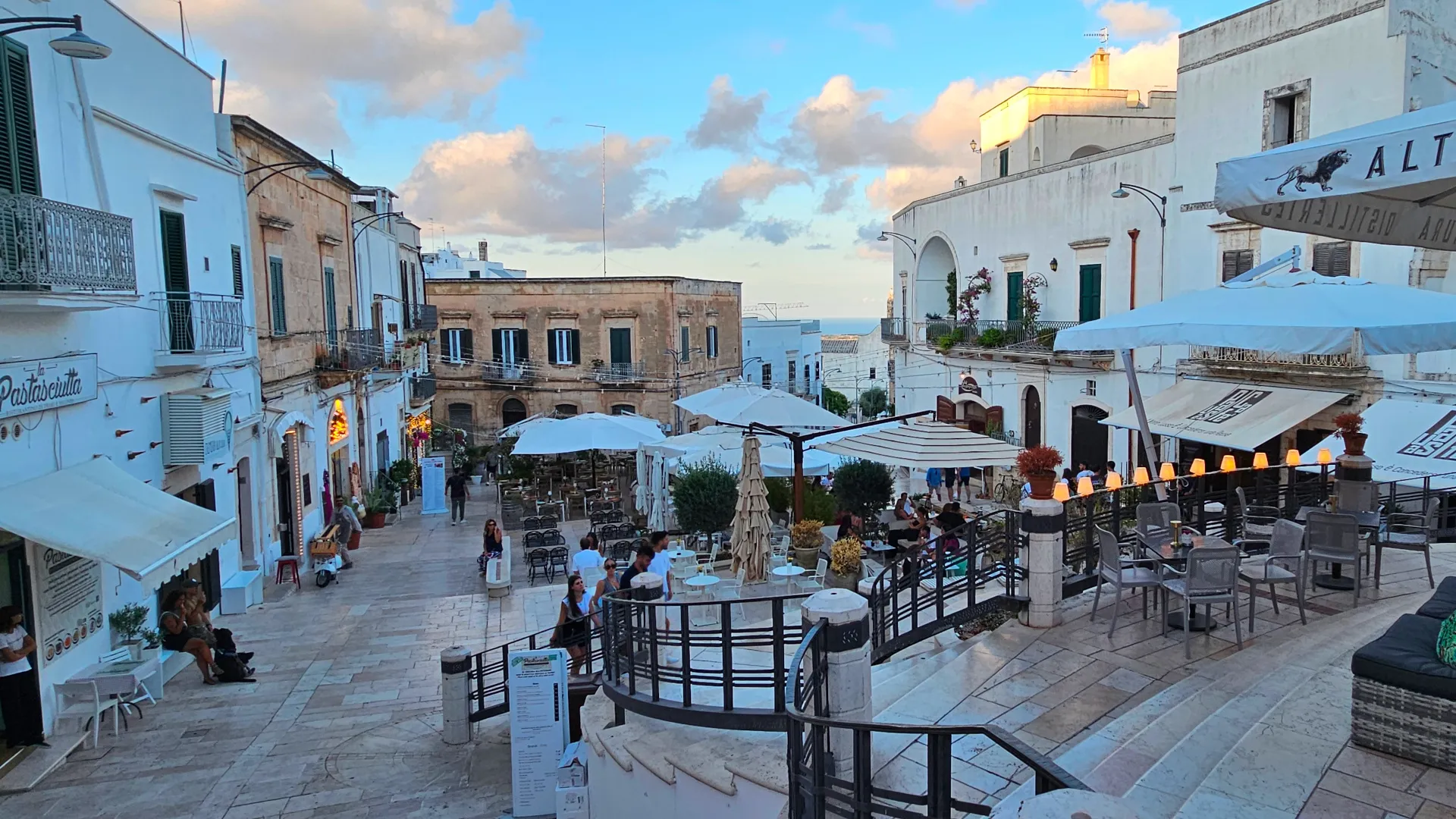
Accommodation and stay in Ostuni
Ostuni offers a wide range of accommodation solutions that can satisfy any type of tourist, from solitary travelers to lovers of luxury, up to families looking for a comfortable stay. Here is a detailed overview of the best stay options in this fascinating city.
Luxury hotel
1. Paragon 700 Boutique Hotel & SPA: Located in the heart of the historic center, this renovated hotel offers a unique experience. Guests can enjoy elegantly furnished rooms, an indoor spa and a gourmet restaurant serving local cuisine with a modern twist.
2. La Sommità Relais & Chateaux: This hotel is located in an ancient noble palace and offers spectacular views of the white city. With just 15 rooms, it guarantees an intimate, high-end experience, complete with excellent food service and an exclusive spa.
3. Masseria Cervarolo: This typical Puglia property is located a short distance from Ostuni and offers an immersion in local culture with its rooms furnished in a rustic and modern style, a panoramic swimming pool and Apulian cooking classes.
Boutique Hotels
1. Masseria Il Frantoio: This masseria, which is also an organic farm, offers an authentic experience with uniquely decorated rooms and a restaurant that uses products from its own farm. It is ideal for nature and organic food lovers.
2. Ostuni Palace – Hotel Meeting SPA: With breathtaking views of the old city, this hotel combines historic charm with modern comforts, offering its guests a full spa and an elegant bar for evening aperitifs.
3. Hotel Monte Sarago: Offers modern hospitality with a splendid view of the city of Ostuni. The rooms are spacious and modernly furnished, and the rooftop terrace is the perfect place to enjoy a drink at sunset.
Bed and Breakfast and Holiday Homes
1. Casa d'Autore: A boutique bed and breakfast located in the historic center, with rooms that mix contemporary design and traditional touches. It is famous for its rich breakfast with local products.
2. Trullo Silentio: Offers a unique experience of staying in a trullo, the typical domed housing structures of the region. Located in the countryside just outside Ostuni, it is perfect for a romantic getaway or family holiday.
3. Masseria Salinola: This ancient farmhouse transformed into a welcoming farmhouse offers rooms and apartments with equipped kitchens, ideal for families or groups. The property also includes a swimming pool and a restaurant serving local dishes.
Booking Tips
- High Season: Ostuni is particularly crowded during the summer months, from June to September. It is advisable to book well in advance to ensure the best accommodation options.
- Location: Choosing accommodation in the historic center can offer a more authentic experience and the convenience of having all the main attractions within walking distance, but can be more expensive. The alternatives in the surrounding area offer tranquility and often more space at lower prices.
- Transport: Check parking availability if you plan to arrive in Ostuni by car, as many hotels in the historic center do not have their own parking and the streets can be very narrow.
Opting for a stay in Ostuni means immersing yourself in an atmosphere rich in history, culture and natural beauty, with a wide choice of accommodation that can make your holiday unforgettable. Whether it is a luxurious historic hotel or a welcoming bed and breakfast, every type of traveler will find the most suitable option to fully experience the magic of Ostuni.
How to get to Ostuni
How to get to Ostuni by plane
Ostuni can be easily reached from all over Europe thanks to the three airports nearby:
- Brindisi airport, the closest, about 35 kilometers away
- Bari airport, the second closest, is about 100 km away or just one hour by car
- Foggia airport, which serves several national flights, is 200 km away or about two hours by car.
Ostuni is about 35 kilometers from Brindisi airport, 100 km from Bari airport and 200 kilometers from Foggia airport, so it can be reached from the airports very quickly by car, from 30 minutes to 2 hours maximum.
For visitors who intend to take a holiday in Ostuni arriving by plane, we recommend renting a car or taking advantage of the many chauffeur-driven transport services available at the airports, in this way you can get to Ostuni in a very short time and at reasonable prices.
If you don't want to drive yourself or don't want to use the shuttles at the airport then you can contact the facilities where you will be staying to ask if they themselves have a shuttle service to and from the airports: they often provide a shuttle service themselves for their guests.
How to get to Ostuni By car
Ostuni can be easily reached by car, from the coast or from the inside it is well connected, but you must then leave the car in one of the parking areas on the edge of the city.
The circulation of cars in the center of Ostuni is forbidden to non-residents and you risk incurring a heavy fine if you do not leave your car in the parking areas outside the historic center.
How to get to Ostuni By train
If you travel by train to reach Ostuni you will realize that the city is well connected with other cities on the eastern coast of Puglia such as Brindisi, Polignano, Monopoli or Bari.
From Ostuni station you can reach the city center, which is just 2 km away, with an inexpensive shuttle bus service that takes tourists to the center in just 5 minutes.
